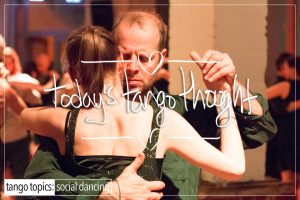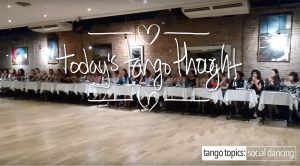These words may come as a surprise to you dear reader considering that this page has seemingly ‘bashed’ or disparaged the role of the Follow in any number of ways, however: The role of the Follower is work.
This is by no means a complete list, but just a taste: A Follower must master in order to ‘dance’ with a particular Lead their stability, their walk backwards, and forwards, and side, without wobbling. They must master turning left and right, in close and open embrace, employing a Follower’s Molinete (the ‘grape vine’ turn) and or any of the 7 other types of turns that they’re led to. Their crosses must be clean (forward or back). They must not ‘plank’ in a Colgada, they must learn to ‘fall’ in a Volcada, and they must learn to step into their lead in a Sacada. They must master their disassociation and applied disassociation in the Ocho, which eventually leads to their ability to Boleo in Circular Boleos. They must adorn and embellish musically between the beats so as not to interrupt the lead (the action and not the person). They must constantly manage their space, their distance, their circular awareness around their lead with where they’re placing their foot and how so as to constantly manage the optimally position of the couple, and at the same time trying to not hit anyone. And all the while their embrace must not hang, pull, push, or constrict the lead’s motion in any way, shape, or form.
That’s work. Hard work.
And all of that is done in 3 in heels, walking backwards whilst some sweaty piece of man has their proverbial meathooks around them, pushing and pulling this way and that, while ‘helping’ them (ahem…read that as ‘correcting them’).
Yup! That sounds like ‘fun’ doesn’t it ? Not to mention there’s so much ‘passion’ there, no ? Not!
Let’s be clear about something, this is ‘work’, all physiological work, it’s labor. A Lead (the person) may not understand just how much work this is until they do the job themselves, and they have the misfortune to ‘dance’ with a lead as characterized above. And at that point their perspective changes. Radically. Why ? Because they don’t want to be that guy. This moment is usually an awakening for the lead because they become Follower sensitive. Their lead changes from force, tension, and resistance moving gradually towards intention, suggestion and invitation.
As to the Follower’s work, it is never done. They’re constantly being challenged by L/leads that are not clear in what they want, and when they are clear usually the L/lead is employing and asking for resistance from them. They must put up with the Lead that talks in their ear while dancing with them (this is talking, not dancing). They have to deal with the lead that squeezes them and then pulled them off balance constantly. While at the same time having a Lead that is watching their feet, and their head is usually pressing against them. They must interpret an unclear beat between two masters (the music, and the lead’s interpretation of that). They must constantly work on their walking technique, forwards, side, and back. Let’s not forget the sensual/sexual issues that come up. And that’s just the tip of the proverbial iceberg.
In short, it’s work.
The Tango Topics Opinion: Follower Technique. The very words spark either abject fear of not being good enough, or another yawn at the prospect of hearing the 10 most common things from some yahoo that knows absolutely diddly about what it means to be a Follower, or their internal voice about not doing enough, not detailed enough, not…. while at the same time they compare themselves to the latest, hot, wild Follower that totally does it for everyone else watching a performance on YouTube. Uuuugh. A nasty, ugly cycle. In all of that mishigas there’s work to be done. These are not mere words, but the reality that real work has to happen. The work, so that we’re clear, is all about 3 steps, and how one takes those steps (extends their legs), how to land the foot in socks, then in flats, and finally in heels. Forward steps. Side steps. Back steps. The step that drives about as much debate as does the debate over peanut butter and jelly or peanut better and _______, is the Back Step and how it should or shouldn’t be done. There are about as many theories and practices about this one step as there are, seemingly, grains of sand on a beach. Everyone has a theory and a YouTube video of a moment in a said video with said Follower did X which all of a sudden proves the point that one method is better than the other. None of it…none of it is true. What is true is the reality that in that moment something had to happen to generate the necessity for a particular type of step to happen. And this is where the “work” of the Follower really begins.
This isn’t about training one kind, or one type of step. It’s about training one’s body, conditioning it, for MULTIPLE kinds of steps in the most common situations. There are steps for the Follower’s Molinete that are ideal. There are steps for the Follower’s side of the Milonguero Turn. There are types of Steps for Traveling Ochos, etc. Hmmmmm, types of steps may be a bit of an overreach. It may be more appropriate to say that these steps are accommodations in each situation. That different situations call for different accommodations, and the Follower must build a LIBRARY of ACCOMMODATIONS! (Ummmm hence the MULTIPLE part) 🙂
In the end, all of this work, is a lot like what happens in the Television Production world which is: Hurry Up and Wait! You do all this work, stream sweat, cry blood, and then you wait for a Lead that is capable of actually leading what you’ve been working towards. And instead the Follower is met with “meh” for their Local Leads that can barely walk without blaming the Follower for X. That rush to do X. That push their Followers to do Y. That Pull their Followers. That squeeze the living daylights (uuuugh) out of their Followers and aren’t even aware that they’re doing it at all! All the while creating situations where the Follower has to accommodate their “peculiar proclivities” of their idea of an Embrace, a Traveling Ocho, an Argentine Cross, and the Follower’s Molinete to the Lead’s Giro! Situations ? Like for instance: The Lazy Man’s Turn ? The Armpit Dancer ? The Five Errors of the Cross ? Just to name a few of the many places where the Follower’s work isn’t on the ideal execution of their Technique, but rather an accomodation of how to deal with a particular Lead’s ‘issues’ which gets labeled as a ‘style’, when in fact it’s something else entirely different than that.
That said, the Follower has an enormous amount of work to do not just in the execution of Technique but also in dealing with a Lead’s ego.
- Glossary: Follower's Molinete
- Glossary: Applied Disassociation
- Glossary: Disassociation
- Glossary: Circular Boleos
- Glossary: Milonguero Turn
- Glossary: Traveling Ocho
- Glossary: Argentine Cross
- Glossary: Open Embrace
- Glossary: Lead's Giro
- Glossary: Resistance
- Glossary: Presentation Tango
- Glossary: Constriction
- Glossary: Intention
- Glossary: Molinete
- Glossary: Cross
- Glossary: Colgada
- Glossary: Pushing
- Glossary: Pulling
- Glossary: Tension
- Glossary: Embrace
- Glossary: Sacada
- Glossary: Walking
- Glossary: Llead
- Glossary: Leading
- Glossary: Lead
- Glossary: Close Embrace
- Glossary: Turns
- Glossary: Ochos
- Glossary: Force











